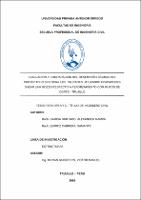| dc.contributor.advisor | Moran Guerrero, Víctor Manuel | |
| dc.contributor.author | García Hurtado, Alexander Ramon | |
| dc.contributor.author | Quiroz Cabrera, Samanta | |
| dc.creator | García Hurtado, Alexander Ramon | |
| dc.date.accessioned | 2021-03-04T00:42:02Z | |
| dc.date.available | 2021-03-04T00:42:02Z | |
| dc.date.issued | 2021 | |
| dc.identifier.uri | https://hdl.handle.net/20.500.12759/7260 | |
| dc.description.abstract | Esta tesis se ha ejecutada con el fin de comparar el uso de muros estructurales de
concreto, que es el que contempla la norma peruana E0.30: Diseño
Sismorresistente, con respecto a los disipadores sísmico Shear Link Bozzo,
contemplados en la norma internacional ASCE 7-16. Se tomó la estructura con
muros estructurales, como la estructura original debido a la cantidad de pisos, por
lo que sin lugar a duda era necesario reforzar. Se efectuó un AENL por el método
de espectro de capacidad, en ambos sistemas, con el fin de identificar curvas de
capacidad y sus puntos de desempeño. El contraste de estas posibilita corroborar
las indudables diferencias entre ambos sistemas, advirtiendo la magnitud en la que
se logra acentuar la resistencia debido a las derivas. De la norma E0.30: Diseño
Sismorresistente, se obtienen los criterios necesarios para precisar el espectro de
diseño y poder realizar los análisis lineales básicos para el diseño de la estructura
que nos funcionarían para concretar el análisis estático no lineal y con esto
identificar y señalar los puntos de desempeño de las estructuras, esto representa
el máximo desplazamiento al que las estructuras están sometidas si se diera lugar
el sismo del diseño, razón por la cual estas se contrastan, junto con la capacidad
estructural. El análisis no lineal, Pushover, demandó obtener la distribución de
fuerzas laterales, calculadas con ayuda del programa Etabs y Excel, y permite
evidenciar la secuencia en la que se forman las rótulas plásticas en las vigas y
columnas según intensifica la cortante basal, por lo cual se concretó un cotejo del
estado estructural en el punto de desempeño, dándonos un parámetro del que nos
logramos orientar para dictaminar cual reforzamiento es apropiado. Nuestros
resultados finales son la comparativa del nivel de desempeño, derivas inelásticas y
cortantes basales para cada sistema de reforzamiento estructural | es_PE |
| dc.description.abstract | This thesis has been executed in order to compare the use of structural concrete
walls, which is the one contemplated by the Peruvian standard E0.30: Seismicresistant Design, with respect to the Shear Link Bozzo seismic dissipators,
contemplated in the international standard ASCE 7 -16. The structure with structural
walls was taken as the original structure due to the number of floors, so without a
doubt it was necessary to reinforce. A non-linear static analysis was carried out by
the capacity spectrum method, in both systems, in order to identify their capacity
curves and their performance points. The contrast of the capacity curves makes it
possible to corroborate the undoubted differences between both systems, noting the
magnitude in which resistance due to drifts is accentuated. From the E0.30
standard: Earthquake Resistant Design, the necessary criteria are obtained to
specify the design spectrum and to be able to carry out the basic linear analyzes for
the design of the structure that would work for us to specify the non-linear static
analysis and with this identify and indicate the performance points of the structures,
this represents the maximum displacement to which the structures are subjected if
the design earthquake were to occur, which is why these are contrasted, together
with the structural capacity. The nonlinear analysis, Pushover, demanded to obtain
the distribution of lateral forces, calculated with the help of the Etabs and Excel
program, and allows to demonstrate the sequence in which the plastic hinges are
formed in the beams and columns as the basal shear intensifies, therefore which
made a comparison of the structural state at the performance point, giving us a
parameter from which we could guide ourselves to determine which reinforcement
is appropriate. Our final results are the comparison of the performance level,
inelastic drifts and basal shear for each structural reinforcement system | en_US |
| dc.description.uri | Tesis | es_PE |
| dc.format | application/pdf | es_PE |
| dc.language.iso | spa | es_PE |
| dc.publisher | Universidad Privada Antenor Orrego | es_PE |
| dc.relation.ispartofseries | T_ING.CIVIL_1922 | |
| dc.rights | info:eu-repo/semantics/openAccess | es_PE |
| dc.rights.uri | https://creativecommons.org/licenses/by/4.0/ | es_PE |
| dc.source | Universidad Privada Antenor Orrego | es_PE |
| dc.source | Repositorio Institucional - UPAO | es_PE |
| dc.subject | Análisis Estructural No lineal | es_PE |
| dc.subject | Derivas | es_PE |
| dc.title | Evaluación y comparación del desempeño sísmico del proyecto residencial los Tulipanes utilizando disipadores Shear Link Bozzo respecto a reforzamiento con muros de corte - Trujillo | es_PE |
| dc.type | info:eu-repo/semantics/bachelorThesis | es_PE |
| thesis.degree.level | Titulo Profesional | es_PE |
| thesis.degree.grantor | Universidad Privada Antenor Orrego. Facultad de Ingeniería | es_PE |
| thesis.degree.name | Ingeniero Civil | es_PE |
| thesis.degree.discipline | Ingeniería Civil | es_PE |
| dc.subject.ocde | https://purl.org/pe-repo/ocde/ford#2.01.00 | es_PE |
| renati.advisor.orcid | https://orcid.org/0000-0001-8125-7462 | es_PE |
| renati.author.dni | 73211761 | |
| renati.author.dni | 71241551 | |
| renati.advisor.dni | 6041113 | |
| renati.type | https://purl.org/pe-repo/renati/type#tesis | es_PE |
| renati.level | https://purl.org/pe-repo/renati/nivel#tituloProfesional | es_PE |
| renati.discipline | 732016 | es_PE |
| renati.juror | Alanoca Quenta, Angel | |
| renati.juror | Cancino Rodas, César | |
| renati.juror | Vertiz Malabrigo, Manuel | |
| dc.publisher.country | PE | es_PE |


